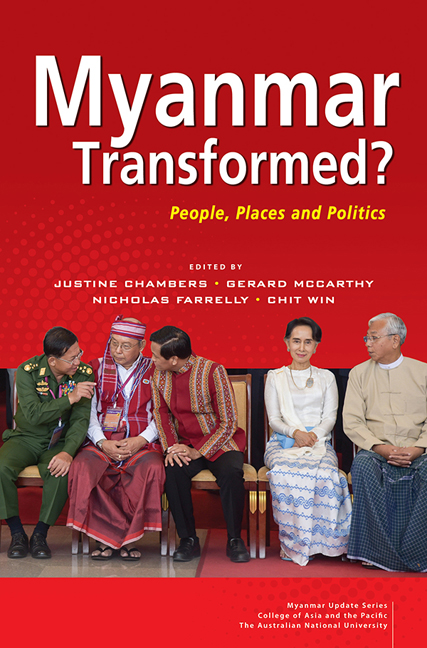Book contents
- Frontmatter
- Contents
- List of Tables
- List of Figuress
- Acknowledgements
- Contributors and Editors
- Part I Introduction
- Part II People
- Part III Places
- 5 Myanmar's Rural Revolution: Mechanization and Structural Transformation
- 6 Change and Continuity: Capacity, Coordination and Natural Resources in Myanmar's Periphery
- 7 Advocacy Organizations and Special Economic Zones in Myanmar
- 8 Explaining Naypyitaw under the National League for Democracy
- Part IV Politics
- Part V Epilogue
- Abbreviations and Key Terms
- Index
6 - Change and Continuity: Capacity, Coordination and Natural Resources in Myanmar's Periphery
from Part III - Places
Published online by Cambridge University Press: 12 February 2019
- Frontmatter
- Contents
- List of Tables
- List of Figuress
- Acknowledgements
- Contributors and Editors
- Part I Introduction
- Part II People
- Part III Places
- 5 Myanmar's Rural Revolution: Mechanization and Structural Transformation
- 6 Change and Continuity: Capacity, Coordination and Natural Resources in Myanmar's Periphery
- 7 Advocacy Organizations and Special Economic Zones in Myanmar
- 8 Explaining Naypyitaw under the National League for Democracy
- Part IV Politics
- Part V Epilogue
- Abbreviations and Key Terms
- Index
Summary
Over the past few years, the Republic of the Union of Myanmar has undertaken a three-pronged transition strategy with regard to politics, the economy, and internal security (Farrelly and Gabusi 2015). The first transition is undoubtedly of a political nature. In 2011, following the adoption of a new constitution three years earlier, the military junta, which had long led the country in the form of the SPDC (State Peace and Development Council), orchestrated a top-down power transition towards a new semi-civilian government led by President Thein Sein. In November 2015, Nobel Peace Prize laureate Aung San Suu Kyi and her tightly controlled party, the National League for Democracy (NLD), won the first democratic general elections in two generations. In March 2016, with the election of NLD loyalist Htin Kyaw as president, Aung San Suu Kyi assumed the roles of Minister of Foreign Affairs, Minister of the President's Office, and State Counsellor, de facto becoming the undisputed civilian leader of the country.
The second transition concerns the economy. With new liberalization Measures. by opening up to trade and foreign direct investment (FDI), and following the suspension or end of international sanctions, Myanmar intends to definitively abandon the socialist autarchy of the past, which had been a weighty burden of General Ne Win's 1962 coup. With an average year-on-year growth rate of more than eight per cent between 2013 and 2016, Myanmar now belongs to the World Bank's group of lower-middleincome countries. Between 2011 and 2014, exports, concentrated in the primary sector, grew at an average rate of eleven per cent, and in fiscal year 2015–16 Myanmar received FDI totalling a record-high 9.4 billion US dollars. However, tied with Cambodia, the country still has the lowest level of GDP per capita in the ASEAN countries at 1,275 current US dollars. Poverty is concentrated in the countryside (where seventy-six per cent of the country's poor reside) and in border areas, only one-third of the population has access to electricity, and fifty-seven per cent of the labour force is still employed in the informal economy (Danish Trade Union Council for International Development Cooperation 2016). According to the UNDP Human Development Index, Myanmar ranks 145th, still among the low human development countries.
- Type
- Chapter
- Information
- Myanmar Transformed?People, Places and Politics, pp. 137 - 160Publisher: ISEAS–Yusof Ishak InstitutePrint publication year: 2018



